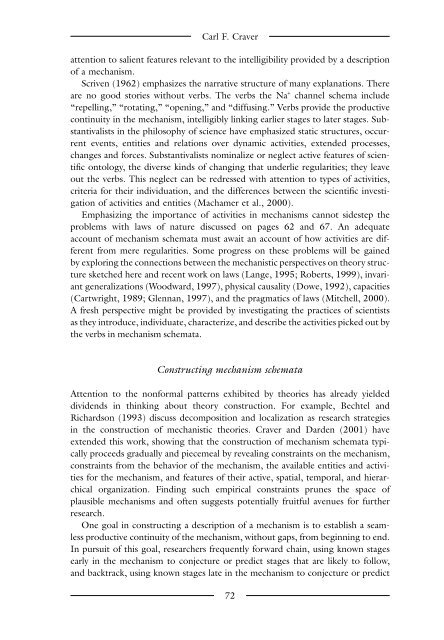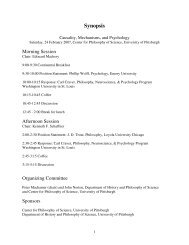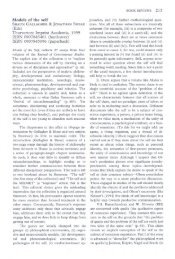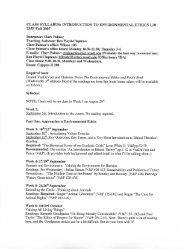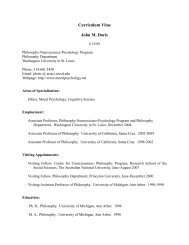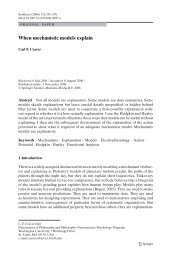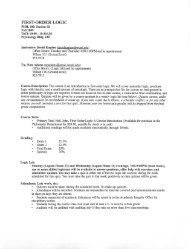The Blackwell Guide to the Philosophy of Science - The Department ...
The Blackwell Guide to the Philosophy of Science - The Department ...
The Blackwell Guide to the Philosophy of Science - The Department ...
Create successful ePaper yourself
Turn your PDF publications into a flip-book with our unique Google optimized e-Paper software.
Carl F. Craver<br />
attention <strong>to</strong> salient features relevant <strong>to</strong> <strong>the</strong> intelligibility provided by a description<br />
<strong>of</strong> a mechanism.<br />
Scriven (1962) emphasizes <strong>the</strong> narrative structure <strong>of</strong> many explanations. <strong>The</strong>re<br />
are no good s<strong>to</strong>ries without verbs. <strong>The</strong> verbs <strong>the</strong> Na + channel schema include<br />
“repelling,” “rotating,” “opening,” and “diffusing.” Verbs provide <strong>the</strong> productive<br />
continuity in <strong>the</strong> mechanism, intelligibly linking earlier stages <strong>to</strong> later stages. Substantivalists<br />
in <strong>the</strong> philosophy <strong>of</strong> science have emphasized static structures, occurrent<br />
events, entities and relations over dynamic activities, extended processes,<br />
changes and forces. Substantivalists nominalize or neglect active features <strong>of</strong> scientific<br />
on<strong>to</strong>logy, <strong>the</strong> diverse kinds <strong>of</strong> changing that underlie regularities; <strong>the</strong>y leave<br />
out <strong>the</strong> verbs. This neglect can be redressed with attention <strong>to</strong> types <strong>of</strong> activities,<br />
criteria for <strong>the</strong>ir individuation, and <strong>the</strong> differences between <strong>the</strong> scientific investigation<br />
<strong>of</strong> activities and entities (Machamer et al., 2000).<br />
Emphasizing <strong>the</strong> importance <strong>of</strong> activities in mechanisms cannot sidestep <strong>the</strong><br />
problems with laws <strong>of</strong> nature discussed on pages 62 and 67. An adequate<br />
account <strong>of</strong> mechanism schemata must await an account <strong>of</strong> how activities are different<br />
from mere regularities. Some progress on <strong>the</strong>se problems will be gained<br />
by exploring <strong>the</strong> connections between <strong>the</strong> mechanistic perspectives on <strong>the</strong>ory structure<br />
sketched here and recent work on laws (Lange, 1995; Roberts, 1999), invariant<br />
generalizations (Woodward, 1997), physical causality (Dowe, 1992), capacities<br />
(Cartwright, 1989; Glennan, 1997), and <strong>the</strong> pragmatics <strong>of</strong> laws (Mitchell, 2000).<br />
A fresh perspective might be provided by investigating <strong>the</strong> practices <strong>of</strong> scientists<br />
as <strong>the</strong>y introduce, individuate, characterize, and describe <strong>the</strong> activities picked out by<br />
<strong>the</strong> verbs in mechanism schemata.<br />
Constructing mechanism schemata<br />
Attention <strong>to</strong> <strong>the</strong> nonformal patterns exhibited by <strong>the</strong>ories has already yielded<br />
dividends in thinking about <strong>the</strong>ory construction. For example, Bechtel and<br />
Richardson (1993) discuss decomposition and localization as research strategies<br />
in <strong>the</strong> construction <strong>of</strong> mechanistic <strong>the</strong>ories. Craver and Darden (2001) have<br />
extended this work, showing that <strong>the</strong> construction <strong>of</strong> mechanism schemata typically<br />
proceeds gradually and piecemeal by revealing constraints on <strong>the</strong> mechanism,<br />
constraints from <strong>the</strong> behavior <strong>of</strong> <strong>the</strong> mechanism, <strong>the</strong> available entities and activities<br />
for <strong>the</strong> mechanism, and features <strong>of</strong> <strong>the</strong>ir active, spatial, temporal, and hierarchical<br />
organization. Finding such empirical constraints prunes <strong>the</strong> space <strong>of</strong><br />
plausible mechanisms and <strong>of</strong>ten suggests potentially fruitful avenues for fur<strong>the</strong>r<br />
research.<br />
One goal in constructing a description <strong>of</strong> a mechanism is <strong>to</strong> establish a seamless<br />
productive continuity <strong>of</strong> <strong>the</strong> mechanism, without gaps, from beginning <strong>to</strong> end.<br />
In pursuit <strong>of</strong> this goal, researchers frequently forward chain, using known stages<br />
early in <strong>the</strong> mechanism <strong>to</strong> conjecture or predict stages that are likely <strong>to</strong> follow,<br />
and backtrack, using known stages late in <strong>the</strong> mechanism <strong>to</strong> conjecture or predict<br />
72


